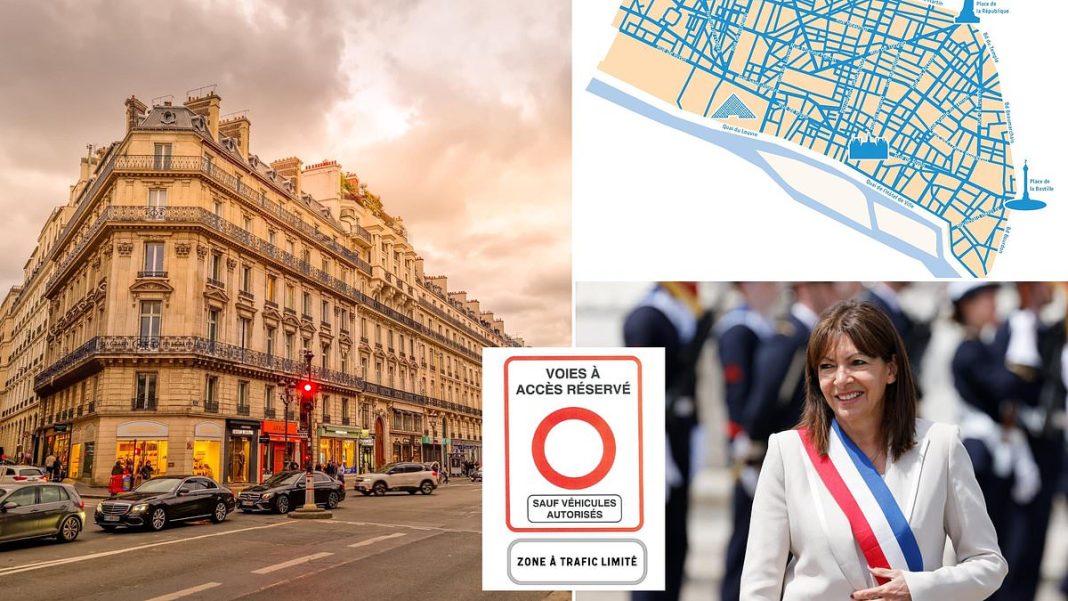- Paris introduces Limited Traffic Zone (ZTL) in the city centre from 5 November
- Enforcement to begin spring 2025 with fines of €135 (£114) for breaching rules
Motorists from this week will be banned from driving through the centre of Paris as the capital’s mayor continues to wage war on motoring.
Anne Hidalgo, the socialist leader who has launched various punitive anti-car measures in her decade-long term, last week published a decree imposing a Limited Traffic Zone (ZTL) in the city.
The scheme, which replicates those already in place in Italian cities -including Milan and Rome – borders an area spanning five square kilometres (around three miles) and encompasses major landmarks including the Louvre, Tuileries Garden, and a large section of the Avenue de l’Opéra.
Following a six-month ‘educational’ grace period where drivers will receive warnings for breaching ZTL rules, thereafter they are set to face fines of €135 (approximately £114).
The Paris ZTL will officially be introduced on Tuesday 5 November as part of a traffic police order co-signed by the Prefect of Police and the Mayor of Paris.
It will be in operation 24 hours a day, seven days a week.
‘As of November 5, 2024, a Limited Traffic Zone is implemented in Paris Center,’ the City of Paris confirms on its website.
Only traffic ‘originating from or destined for the streets within this perimeter’ will be authorised to travel through the area, which covers the first four arrondissements including the homes of around 100,000 people and 110,000 business premises.
‘Conversely, transit traffic (crossing the zone) is prohibited,’ it added.
Currently, between 350,000 and 550,000 vehicles are estimated to pass through central Paris every day.
However, officials argue that 70 per cent are ‘convenience’ journeys rather than necessity, which unnecessarily adds to both air and noise pollution levels.
Mayor for the city centre region, Ariel Weil, said: ‘The ZTL is an important new step that will be gradually implemented starting with the educational phase.
‘Its effects will combine with those of the traffic plan, with the dual aim of reducing traffic and making it more fluid.’
Paris isn’t the first city in France to introduce a ZTL; Nantes adopted the scheme back in 2012, while similar zones are relatively abundant in Italy, including in Florence and Pisa.
They differ from ‘Low Emission Zones’, like the London ULEZ, Birmingham CAZ and Scottish LEZ scheme, which are charges levied based on a vehicle’s emissions, and is most similar to the Congestion Charge Zone in Centre London.
In a promotional video launching the scheme, Paris City Hall says ZTL will ‘lower traffic to be able to reshape mobility and mobility public space in favour of pedestrians, public transport and bicycles’.
How does the Paris ZTL work?
Apart from locals living within the Paris ZTL, access will be permitted only to emergency vehicles, buses, taxis and people with reduced mobility.
Only cars, vans, lorries, motorcycles, mopeds and scooters deemed ‘destination traffic’ will be allowed free access. There is also no exemption for electric or hybrid cars.
Destination traffic relates to any vehicle that stops within the zone limits for a variety of specific reasons, including getting to work, medical appointments, shopping, dining and even going to the cinema.
The zone’s limit will be highlighted with new signage deployed at the perimeter.
Wardens will initially issue warnings for six months before the arrival of financial penalties.
Hidalgo, who has been pushing for a ZTL in the city since 2021, is yet to outline how the rules will be enforced from spring 2025, though has promised to confirm this shortly.
However, it is widely expected that she will employ a Covid-style system of proof-of-residence and online declarations, both of which were used to stem the spread of the virus during lockdowns.
This could see motorists needing to provide proof of why they travelled in the zone by presenting shopping receipts and restaurant or theatre bills.
Residents in the zone are likely to be issued permits, though this is also yet to be rubberstamped.
Despite there being many exemptions as part of the ZTL, the city estimates it will trigger a ‘substantial’ 30 per cent decline in traffic on major roads through the centre of the French capital and result in a fall in air and noise pollution.
Hidalgo hellbent on banning cars from Paris
Since her election in 2014, Ms Hidalgo has made clear her ambitions of culling vehicles from the capital.
Introduction of the ZTL scheme comes just weeks after she upped efforts to force motor vehicles out of the city with a double whammy of a reduced speed limit on the capital’s ring road and outlawing sales of diesel fuel at four major filling stations on the city’s outskirts.
Hidalgo last month slashed the speed limit on the Périphérique – the capital’s busy eight-lane motorway – to just 31mph (50kmh) from 44mph (70kmh) in a move that has made journeys into Paris increasingly arduous for thousands of commuters.
The four popular filling stations on the capital’s ring road that were banned from selling diesel also from October had previously accounted for half of all diesel receipts in the city.
During the mayor’s 10-year term, she has made streets narrower with the creation of new cycle lanes and pavements, and pedestrianized the popular shopping hotspot, Rue de Rivoli.
She is also the driving force behind higher charges for owners of larger vehicles parking in the city.
In central Paris, SUVs face a staggering £190 for parking over six hours, which is more than three times the cost to park a smaller car (which is around £63).
Closer to home, some fear that such extreme measures to deter driving in Paris could be replicated by London’s Mayor.
Sadiq Khan, who has spearheaded the expansion of the much-hated Ultra Low Emission Zone, has previously expressed admiration for some of Hidalgo’s policies, particularly her decision to hike parking charges for SUVs.
In February, Mr Khan described the move as ‘innovative’.









